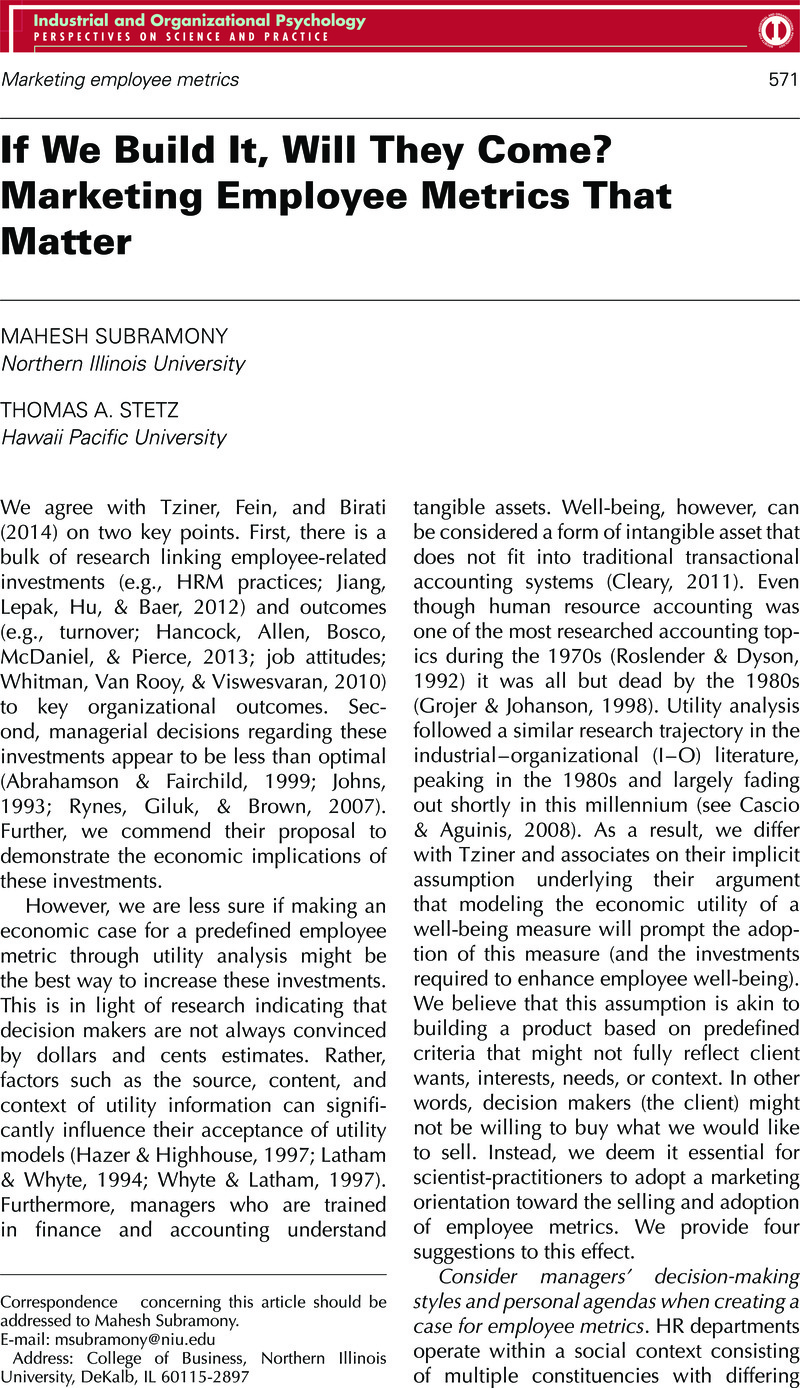No CrossRef data available.
Article contents
If We Build It, Will They Come? Marketing Employee Metrics That Matter
Published online by Cambridge University Press: 10 April 2015
Abstract
An abstract is not available for this content so a preview has been provided. Please use the Get access link above for information on how to access this content.

- Type
- Commentaries
- Information
- Copyright
- Copyright © Society for Industrial and Organizational Psychology 2014
References
Abrahamson, E., & Fairchild, G. (1999). Management fashion: Lifestyles, triggers, and collective learning processes. Administrative Science Quarterly, 44, 708–741.Google Scholar
Cascio, W. F., & Aguinis, H. (2008). Research in industrial and organizational psychology from 1963 to 2007: Changes, choices, and trends. Journal of Applied Psychology, 93, 1062–1081.CrossRefGoogle ScholarPubMed
Cleary, P. (2011). Human resource accounting. In McGuire, D., & Jørgensen, K. M. (Eds.), Human resource development: Theory & practice (pp. 44–54). Thousand Oaks, CA: Sage.CrossRefGoogle Scholar
Dutton, J. E., & Ashford, S. J. (1993). Selling issues to top management. Academy of Management Review, 18(3), 397–428.CrossRefGoogle Scholar
Grojer, J. E., & Johanson, U. (1998). Current development in human resource costing and accounting. Accounting, Auditing and Accountability Journal, 11, 495–505.CrossRefGoogle Scholar
Hancock, J. I., Allen, D. G., Bosco, F. A., McDaniel, K. R., & Pierce, C. A. (2013). Meta-analytic review of employee turnover as a predictor of firm performance. Journal of Management, 39, 573–603.CrossRefGoogle Scholar
Hazer, J. T., & Highhouse, S. (1997). Factors influencing managers' reactions to utility analysis: Effects of SDY method, information frame, and focal intervention. Journal of Applied Psychology, 82(104), 112.CrossRefGoogle Scholar
Heskett, J., Sasser, W. E. J., & Schlesinger, L. (1997). The service profit chain: How leading companies link profit and growth to loyalty, satisfaction, and value. New York, NY: Free Press.Google Scholar
Jiang, K., Lepak, D. P., Hu, J., & Baer, J. C. (2012). How does human resource management influence organizational outcomes? A meta-analytic investigation of mediating mechanisms. Academy of Management Journal, 55, 1264–1294.Google Scholar
Johns, G. (1993). Constraints on the adoption of psychology-based personnel practices: Lessons from organizational innovation. Personnel Psychology, 46, 569–592.Google Scholar
Kaplan, R. S., & Norton, D. P. (1992). The balanced scorecard – Measures that drive performance. Harvard Business Review, 70(1), 71–80.Google Scholar
Kaplan, R. S., & Norton, D. P. (2000). Having trouble with your strategy? Then map it. Harvard Business Review, 78(5), 167–177.Google Scholar
Latham, G. P., & Whyte, G. (1994). The futility of utility analysis. Personnel Psychology, 47, 31–46.CrossRefGoogle Scholar
Roslender, R., & Dyson, J. R. (1992). Accounting for the work of employees: A new look at an old problem. British Accounting Review, 24, 311–329.Google Scholar
Rynes, S. L., Giluk, T. L., & Brown, K. G. (2007). The very separate worlds of academic and practitioner periodicals in human resource management: Implications for evidence-based management. Academy of Management Journal, 50, 987–1008.CrossRefGoogle Scholar
Subramony, M. (2006). Why organizations adopt some human resource management practices and reject others: An exploration of rationales. Human Resource Management, 45(2), 195–210.CrossRefGoogle Scholar
Thomas, D. A., & Creary, S. J. (2009). Meeting the diversity challenge at PepsiCo: The Steve Reinemund Era, Harvard Business School Press, MA: Cambridge. (Harvard Business Press Case 9-410-024).Google Scholar
Tsui, A. S., & Milkovich, G. T. (1987). Personnel department activities: Constituency perspectives and preferences. Personnel Psychology, 40, 519–537.Google Scholar
Tziner, A., Fein, E. C., & Birati, A. (2014). Tempering hard times: Integrating well-being metrics into utility analysis. Industrial and Organizational Psychology: Perspectives on Science and Practice, 7(4), 554–568.Google Scholar
Whitman, D. S., Van Rooy, D. L., & Viswesvaran, C. (2010). Satisfaction, citizenship behaviors, and performance in work units: A meta-analysis of collective construct relations. Personnel Psychology, 63, 41–81.Google Scholar
Whyte, G., & Latham, G. (1997). The futility of utility analysis revisited: When even an expert fails. Personnel Psychology, 50, 601–610.CrossRefGoogle Scholar




